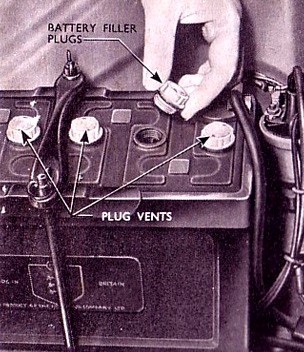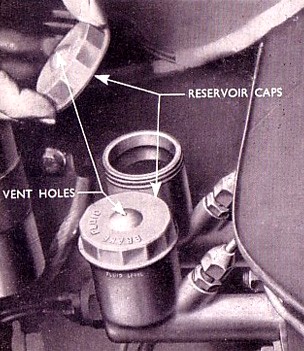You are in:

Weekly
Check
and Service |

Ford
Anglia 105E - Weekly Check and Service Schedule
| It is impossible
to over emphasise the importance of correct
lubrication, inspection and running adjustments,
if you wish to obtain the best level of service
from your Ford Anglia.Each week there will be the
usual four Daily Checks and at least four other
minimum checks you should do to your vehicle. The Weekly service also
incorporates:
(Key: This Colour = Daily Service items)
Check
the Engine Oil
Level
Check the Radiator
Level
Check the Petrol
Level in the Tank
Check the Windscreen is Clean
Check the Battery Electrolyte Level
Check the Brake and Clutch Fluid Reservoir Levels
Check the Operation of all Lights
Check the Tyre Pressures
|
Check the Battery
Electrolyte Level
The battery is
accessibly located under the bonnet, within the
engine compartment. Remove the filler caps and
check that the electrolyte in each cell is 1/4 to
3/8 in (6.35 to 9.525 mm) above the tops of the
plates. If below this level add distilled water
as necessary. (In cold weather the distilled
water should only be added immediately before
running the engine, so that when the generator is
charging, the water and electrolye will mix and
prevent freezing.) The filler caps can now be
refitted.Keep the battery filler
caps and battery connections tight and the top of
the battery clean.
A
coating of petroleum jelly will protect the
battery terminals. Occasionally check the battery
clamp to ensure that the mounting wings nuts are
tight and the battery is still secure in the
battery tray.
Excessive
use of distilled water by the battery is usually
an indication of an unduly high
generator-charging rate and you should consult an
Auto Electrician or your Authorised Ford Dealer
and have the charging system checked.
|
 |
Check the Brake and Clutch
Fluid Reservoir Levels
The brake and clutch fluid reservoirs are located
in the engine compartment on the driver’s
side of the car and are integral with their
master cylinders. When checking or replenishing
the system wipe the sides of the reservoirs and
caps with a clean dry cloth to prevent any dirt
entering the system. Do not use a cloth that is
greasy or has been soaked in petrol or paraffin
etc.Remove each cap by unscrewing it and
top up if necessary to the level indicated on the
reservoir casing (approximately 5/8 in (16mm)
from the rim). Use only the correct brake fluid, obtainable from your Authorised
Ford Dealer.
Warning
– MINERAL OILS MUST NOT BE USED IN ANY
CIRCUMSTANCES FOR TOPPING UP THE RESERVOIRS.
|
 |
Check the Tyre Pressures
It is necessary to keep the tyre pressures at the
specified figures, checking the pressures at
least once a week is recommended. It's not always
apparent that air is being lost, but it generally
escapes at the rate of up to two pounds of air
every month. More air is usually lost during warm
weather, so more regular checks are needed when
temperatures rise. Incorrect tyre pressures or
excessive wear can adversely affect the steering
and braking of the car. The tyre pressure should
be checked before a run whilst the tyres are
cold, as a hot tyre will give a higher reading.
If the tyres are checked hot, do not, in any
circumstances, bleed off this increase in
pressure.
The air pressure in the tyres has a pronounced
effect on the action of the brakes, as well as
the correct operation of the front suspension and
steering gear. |
 |
To check the
pressure of a tyre, remove the valve cap and
press a suitable tyre gauge firmly ito place. If
necessary sufficient air should be added to bring
the tyre pressure up to the amount specified. Do
not forget to check the pressure of the spare
wheel.
Do not forget to refit the valve cap.Unequal or insufficient
pressure results in rapid wear, uneven braking
and heavy steering.
The correct tyre
pressures are:
Anglia Saloon - 22lb/sq in (1.54 kg/sq cm) front
and rear
Anglia Estate – 24 lb/sq in (1.69 kg/sq cm)
front and 30 lb/sq in (2.11 kg/sq cm) rear
Anglia 5cwt Van - 24 lb/sq in (1.69 kg/sq cm)
front and rear
Anglia 7cwt Van - 24 lb/sq in (1.69 kg/sq cm)
front and 30 lb/sq in (2.11 kg/sq cm) rear
More information about tyres is contained in the General
Maintenance for Wheels and Tyres Page
Check the
Operation of all Lights
Operate all of the lights one at a time and check
that they operate correctly and that there are no
blown bulbs. As well as it being unsafe to drive
without operating lights, it is also an offense
in the UK.
To replace any of the bulbs, follow the steps at
the General Maintenance for
Lights
Page.
|
Information taken from Various Ford
Anglia Instruction Books and Handbooks.

Warning -
The Health and Safety bit.
Please note your health may be at
risk if you do not take sensible safety
precautions. Never work under an unsupported
vehicle, do not take shortcuts. If you feel that
the task is beyond your capabilities, then employ
the services of a trained professional. The Owner
of this Website nor the author cannot be held
responsible for any accidents or injury arising
from advice given on this webpage. Safety advice
can be obtained from the RoSPA.
|




|
|

